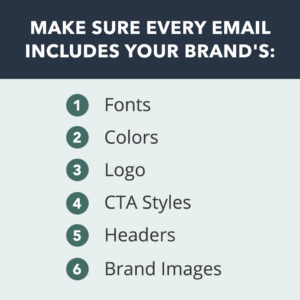Let’s begin with the numbers. Email marketing has a 4,200% Return on Investment (ROI), and 64% of small businesses use email to reach customers, making it an essential marketing tool for any brand.
As a digital marketing agency, we love supporting others in our space by sharing favorite paid media trends or providing email marketing design hacks that actually move the needle.
Ready to improve your email design? Continue reading to learn about our best practices for elevating email design.
1. Start With Your Metrics
It’s hard to improve email design if you don’t know where to start. As a first step, review any campaigns from the last six months and check your email marketing platform’s dashboard or Google Analytics to understand performance. Then compare those metrics to Mailchimp’s Marketing Benchmarks by Industry page to see whether you’re successful in your space in terms of averages.
Then, review click maps of any high-performing campaigns to learn how subscribers engage with your emails. Pay particular attention to engagement on the hero image (large banner image), calls to action (CTAs), hyperlinks, and the length of your emails to see if you need to make design changes.
Next, set a six-month goal to reach your industry’s click rate if you’re not. If you are, increase targets by 10% over your current performance. In either situation, the goal is to make data-informed decisions by knowing where your design succeeds.
2. Stay on Brand

Emails are a gateway to your website, so they need to follow the same design principles as your brand or similar enough to avoid confusion.
For example, BLD PNW needed a full suite of branding and design services for their 2019 conference that mirrored their regional efforts as a B Corp. While we didn’t handle email on that project, the same design rules still applied: Deliver a consistent cross-channel experience across all assets.
Make sure every email includes your brand’s:
- Fonts
- Colors
- Logo
- CTA styles
- Headers
- Brand images
3. Delight With Movement
Hubspot recently reported that 81% of marketers feel that video impacts sales positively. Additionally, emails sent with gifs or a video saw click-through rates increase by 96%.
Adding movement when you are designing emails is one of the best ways to increase click rates. For example, if you’re an e-commerce designer, add a gif that rotates through different products covered in a campaign or place a play button on an image to encourage views and clicks.
4. Make Your Emails Mobile Responsive
Generally, 63% of subscribers read emails on mobile devices, making it essential for desig
ners to create mobile-friendly emails.
If you’re new to this term, let’s define it. Mobile responsiveness is when an email has two layers of CSS code used to adopt a desktop design to a phone. When you apply that code, any assets and layouts become optimized, elevating the user experience and improving your creatives.
5. Personalize Your Emails
Seventy-two percent of consumers say they only engage with personalized content. So, should you use personalization in your marketing emails? Yes.
The good news is that email platforms like Klaviyo and Mailchimp simplify personalization by offering customizable segments, content blocks, and merge tags based on subscriber profiles.
Take a look at our marketing strategy for Palmer College of Chiropractic. You’ll notice we increased leads by 80% by sending 62,464 nurturing emails to thousands of subscribers by individualizing their experiences. We did that by offering custom CTAs, providing personalized design assets based on location, and using behavioral triggers.
We went the extra mile to personalize these emails because we wanted to ensure each student experienced a design that spoke to them while giving them the content they needed to encourage engagement.
6. Learn From A/B Tests
We love testing different design assets to understand how subscribers engage with our emails. For example, we saw a 2% increase in click-throughs when experimenting with longer paragraphs vs. shorter paragraphs. We also saw more engagement when testing different imagery and CTA styles in our marketing emails.
Beyond our work, brands that include an A/B test in their emails typically generate an ROI of 48:1, signaling that testing works. If you’re new to A/B testing, start with practical design elements like the ones we used to start moving the needle.

7. Grow Your Audience
Understanding your acquisition points is key to growing your email marketing lists. Design also plays a massive part in growing subscribers. If you’re new to email marketing, the acquisition strategies we use include:
- Website pop-ups
- Reaching new subscribers over social networks
- Targeting through paid media
- Opt-ins on landing pages
If you aren’t using any of those four acquisition points, design a pop-up or a landing page tailored to your branding and voice. To encourage sign-ups, add motion or gifs to make your design pop.
Remember that every subscriber on your list must opt into marketing emails for non-transactional emails, regardless of where you acquired subscribers, to meet GDRP and CCPA compliance.
Let’s Get Creative
We take a data-driven approach to design by telling our clients’ stories visually. So, in addition to email marketing design, we excel in creating content for any digital channel, whether you need an animated video or an infographic.
Want to learn more about the benefits of working with Mad Fish? Explore our design services page or nerd out about awesome creative by contacting us—we want to hear from you!

